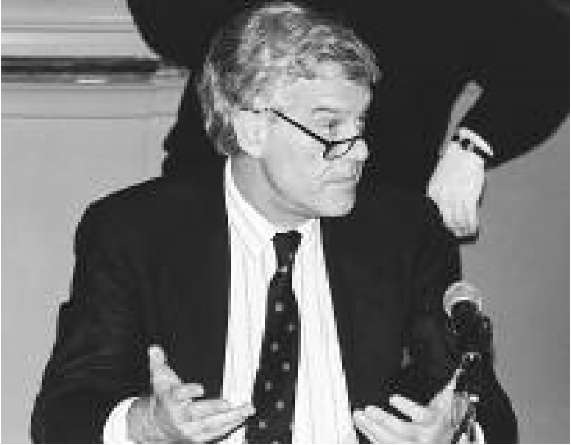(1940- ) Dutch Paleomagnetist
If a magnet is heated above its Curie temperature, it becomes nonmagnetic. If cooled back down it will again be magnetized but its north and south poles will be oriented parallel to the Earth’s magnetic field regardless of its orientation prior to heating. When an igneous rock cools through the Curie temperature for magnetite (578°C), the poles in the magnetite grains will align with the Earth’s field. If magnetite grains are carried in suspension in water, they will spin like a compass needle and align with the Earth’s field as they settle to the ocean floor. These records of the position of the Earth’s magnetic field are paleomag-netics and are measured by a paleomagnetist or paleomagician as some geologists fondly call them. Rob Van der Voo is undoubtedly the world’s foremost authority on paleomagnetics. He established himself in this position during the most important time for paleomagnetics: the plate tectonic revolution; and his papers “Paleomagnetics, Continental Drift and Plate Tectonics” and “Paleomagnetism in Orogenic Belts” are classics.
By measuring the orientations of the magnetic field through a sequence of rock with known ages, Van der Voo charted changing field orientations with time, yielding apparent polar wandering paths. However, it was not the pole that was wandering but rather the continent that was wandering within the magnetic field as described in his paper, “A Method for the Separation of Polar Wander and Continental Drift.” The technique is very sensitive to latitude positions but insensitive to changes in longitude. By correlating the paleomag-netism with paleoenvironmental analysis of the sedimentary rocks, paleoecological analysis of the fossils and any other pertinent information, Van der Voo, along with colleagues Scotese, Ziegler, and Bambach, was able to construct full animations of plate movements and interactions throughout the Paleozoic. This mammoth project was a giant step in plate tectonics, and results of their work now appear in every historical geology textbook. This reconstruction continues to be revised on a yearly basis as new data are received. Several studies on this work include Paleozoic Base Maps and A Paleomagnetic Reevaluation of Pangea Reconstructions.
Van der Voo is not only involved in such large-scale projects. He also addresses local problems using paleomagnetics and continues to add local information to the large database on plate movements with these regional projects. These projects chart deformation and bending or rotation of areas that either support geological studies or identify processes that would not otherwise be recognized without paleomagnetics. He also discovered how easily some types of rock become remagnetized through burial processes, which he continues to study. Finally, he is involved in establishing paleo-magnetics as a method of geochronology.
Rob Van der Voo was born on August 4, 1940, in Zeist, the Netherlands. He attended University of Utrecht, the Netherlands, where he earned a bachelor of science degree in geology in 1961, a master of science degree in geology in 1965, a master of science degree in geophysics in 1969, and a doctorate in geology and geophysics in 1969. He began his career at the University of Michigan in Ann Arbor in 1970, and remains there today. He served as department chair in 1981 to 1988 and in 1991 to 1995 and director of the honors program in 1998 to the present. He was the Arthur F. Thurnau Professor of geology in 1994 to 1997. During his residence at University of Michigan, he was a visiting scholar at many programs, including Lamont-Doherty Observatory of Columbia University, New York (1976), University of Rennes, France (1977), University of Kuwait (1979), University of Texas at Arlington (1984), Greenland Geological Survey (1985), Instituto Jaume Almera, Barcelona, Spain (1990-1991), and Universities of Utrecht and Delft, the Netherlands (1997-1998). Rob Van der Voo married Tatiana M. C. Graafland in 1966 and they have two children. He is fluent in English, French, Dutch, Spanish, and German.
Rob Van der Voo at a forum at the University of Michigan
Van der Voo is an author of an impressive 225 articles in international journals and professional volumes. Many of these are the seminal studies on paleomagnetism and plate tectonic reconstructions. He also edited one professional volume and wrote one book. He has received many honors and awards in recognition of his contribution to the field. He was elected to both the Royal Academy of Sciences of the Netherlands (1979) and the Royal Norwegian Society of Sciences and Letters (1995). He received the G.P. Woollard Award from the Geological Society of America in 1992 and was named an A.V. Cox Lecturer by the American Geophysical Union in 1997. From University of Michigan he received the Henry Russel Award (1976), the Distinguished Faculty Achievement Award (1990), three Excellence in Education Awards (1991, 1992, 1993), and he was named a Distinguished Faculty Lecturer in 1998. In 2001, he received the Benjamin Franklin Medal in Earth Sciences from the Franklin Institute in Philadelphia.
Van der Voo’s service to the profession is remarkable. The committees upon which he has served are too numerous to list here but between Geological Society of America and American Geophysical Union, they number in the 20s. He served as president of the Geomagnetism and Pa-leomagnetism Section of American Geophysical Union in 1988 to 1992. He has served as editor for Geophysical Research Letters, and Earth and Planetary Science Letters and associate editor of Tectonics, Geology, Tectonophysics, Geological Society of America Bulletin, and several others. He was part of several National Research Council and National Science Foundation committees and panels as well as a subcommittee for the National Academy of Sciences. He was on the evaluation committee for geoscience departments at eight universities.

